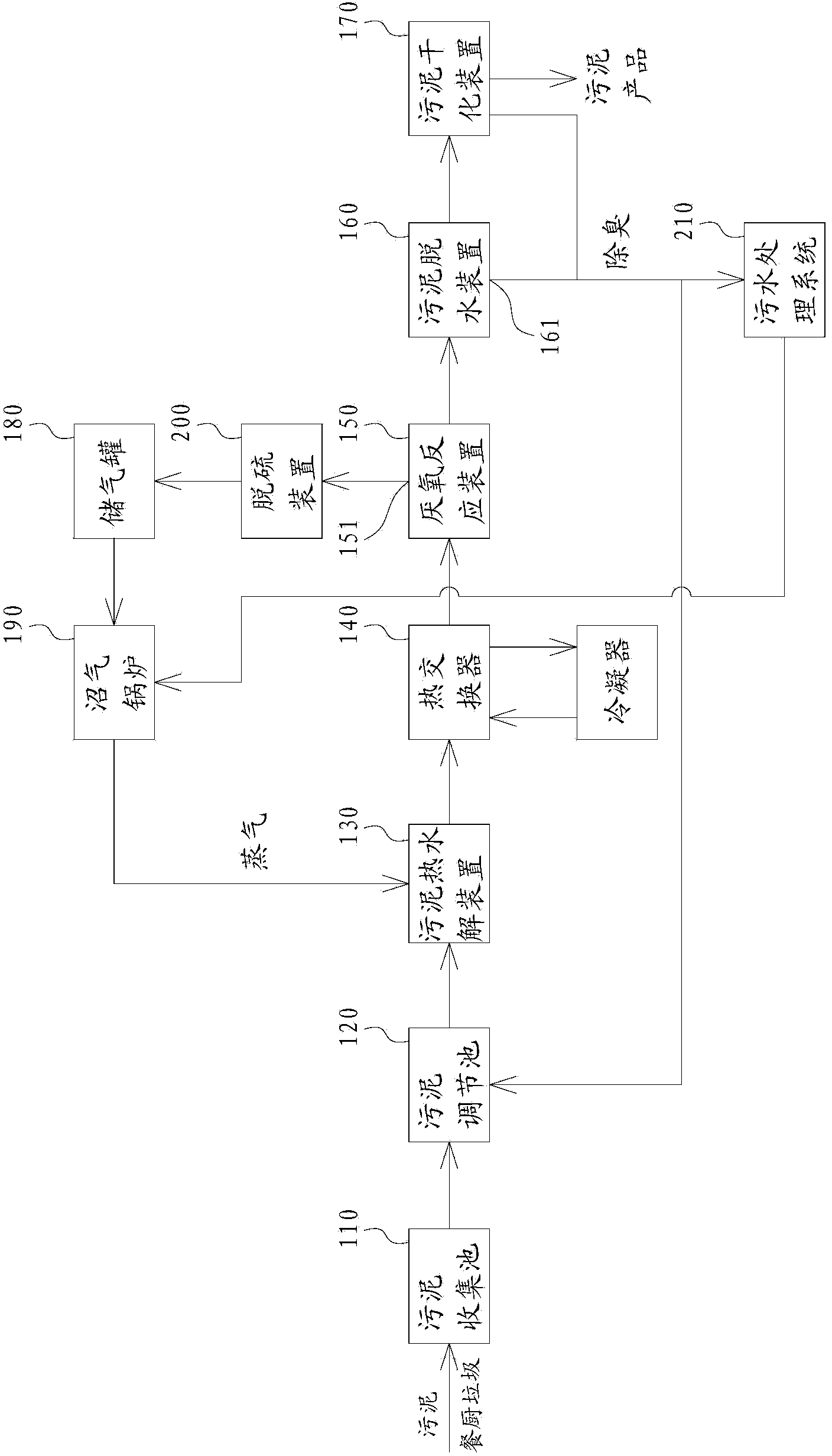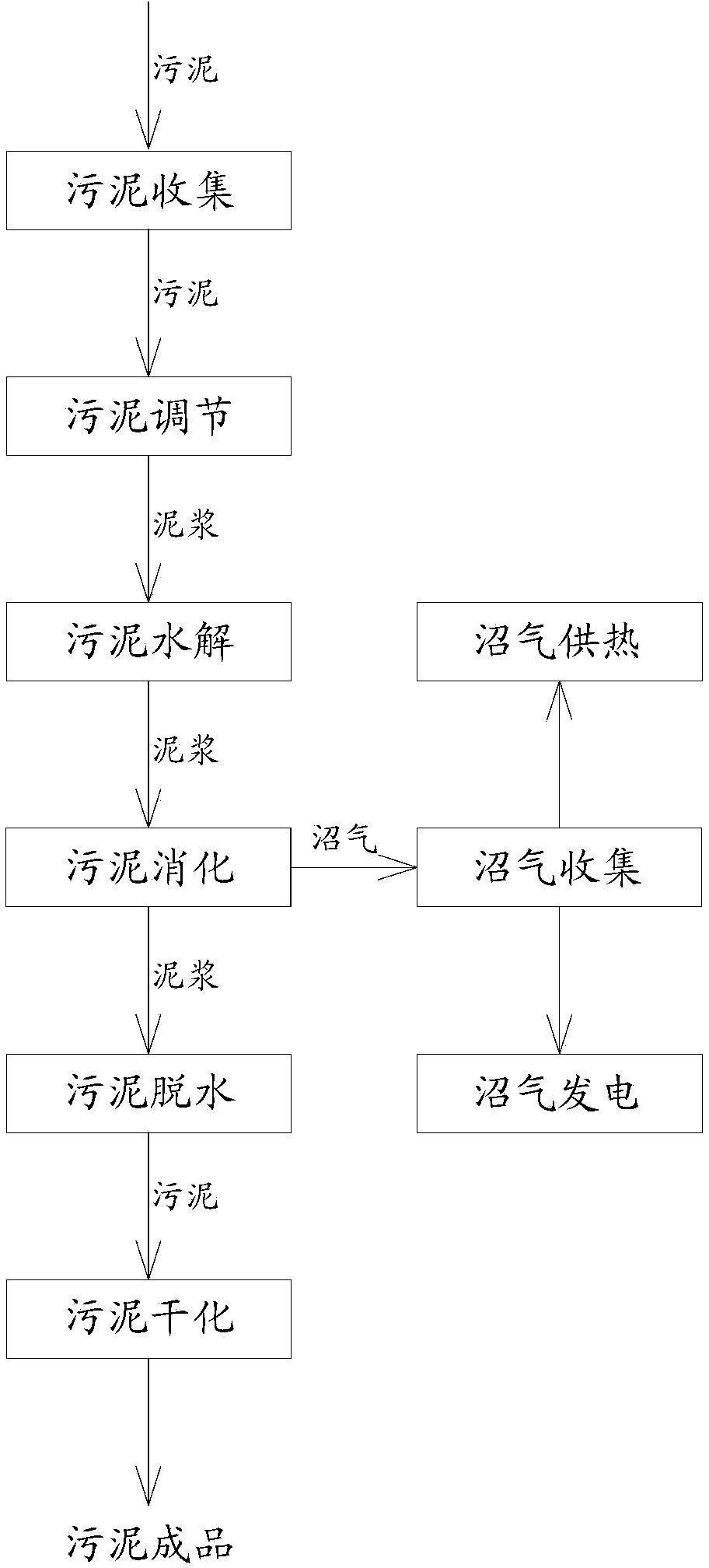Sludge treatment system and sludge treatment method
A sewage treatment system and sludge treatment technology, used in sludge treatment, biological sludge treatment, water/sludge/sewage treatment, etc.
- Summary
- Abstract
- Description
- Claims
- Application Information
AI Technical Summary
Problems solved by technology
Method used
Image
Examples
Embodiment 1
[0041] Sludge from urban sewage plants and kitchen waste are mixed at a ratio of 4:1 in the sludge collection tank 110, and then filtered through the filter grid and then transported to the sludge adjustment tank 120, where the water content of the sludge is adjusted to 80%. Then the sludge is transported to a closed sludge hydrolysis tank with a screw pump, and the high-pressure steam is directly passed into the sludge hydrolysis tank to heat the sludge, and the sludge is heated to 135°C and kept for 2 hours for hydrolysis. The hydrolyzed sludge was transported to the heat exchanger 140 by a screw pump to cool down to 45°C, and then transported to a closed anaerobic reaction tank for anaerobic digestion for 17 days. The biogas produced in the anaerobic digestion process is desulfurized by the sulfur device 200 and sent to the gas storage tank 180 for storage. The digested sludge produced after anaerobic digestion is dehydrated and dried by a plate and frame mud compactor and ...
Embodiment 2
[0043] Industrial wastewater sludge and kitchen waste are mixed at a ratio of 5:1 in the sludge collection tank 110, and then filtered through the filter grid and then transported to the sludge adjustment tank 120, where water is added to adjust the water content of the sludge to 85%. The sludge is transported to a closed sludge hydrolysis tank by a screw pump, and the high-pressure steam is directly passed into the sludge hydrolysis tank to heat the sludge, and the sludge is heated to 133°C and kept for 3 hours for hydrolysis. The hydrolyzed sludge is transported to the heat exchanger 140 by a screw pump to cool down to 45° C., and then transported to a closed anaerobic reaction tank for anaerobic digestion for 16 days. The biogas produced in the anaerobic digestion process is desulfurized by the sulfur device 200 and sent to the gas storage tank 180 for storage. The digested sludge produced after anaerobic digestion is dehydrated and dried by a plate and frame mud compactor ...
Embodiment 3
[0045] Industrial wastewater sludge, urban sewage plant sludge and kitchen waste are mixed in the sludge collection tank 110 at a ratio of 2:2:1, and then filtered through the filter grid and then sent to the sludge adjustment tank 120, where the sludge is adjusted to the sludge level by adding water. The water content of the sludge is 90%, and then the sludge is transported to the closed sludge hydrolysis tank by the screw pump, and the high-pressure steam is directly passed into the sludge hydrolysis tank to heat the sludge, and it is heated to 137°C for 4 hours. hydrolysis. The hydrolyzed sludge is transported to the heat exchanger 140 by a screw pump and cooled to 45° C., and then transported to a closed anaerobic reaction tank for anaerobic digestion for 18 days. The biogas produced in the anaerobic digestion process is desulfurized by the sulfur device 200 and sent to the gas storage tank 180 for storage. The digested sludge produced after anaerobic digestion is dehydra...
PUM
 Login to View More
Login to View More Abstract
Description
Claims
Application Information
 Login to View More
Login to View More - R&D
- Intellectual Property
- Life Sciences
- Materials
- Tech Scout
- Unparalleled Data Quality
- Higher Quality Content
- 60% Fewer Hallucinations
Browse by: Latest US Patents, China's latest patents, Technical Efficacy Thesaurus, Application Domain, Technology Topic, Popular Technical Reports.
© 2025 PatSnap. All rights reserved.Legal|Privacy policy|Modern Slavery Act Transparency Statement|Sitemap|About US| Contact US: help@patsnap.com


